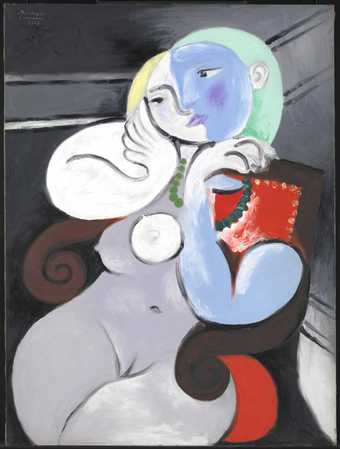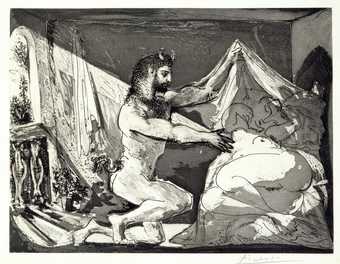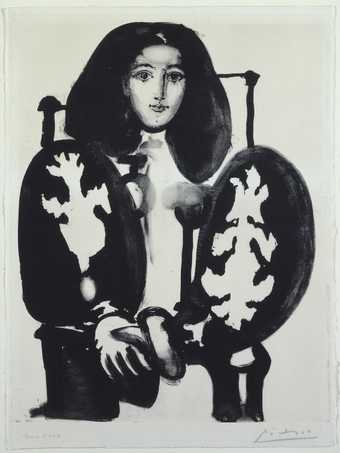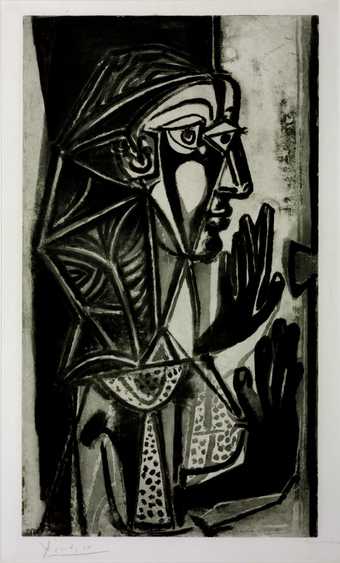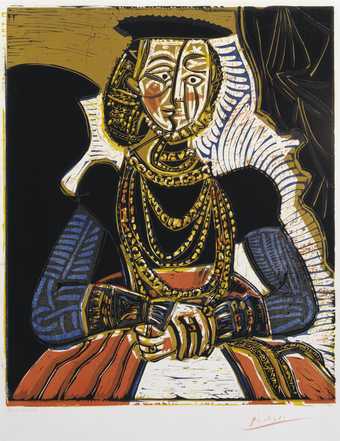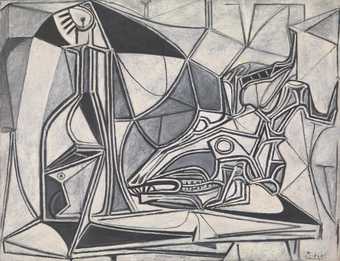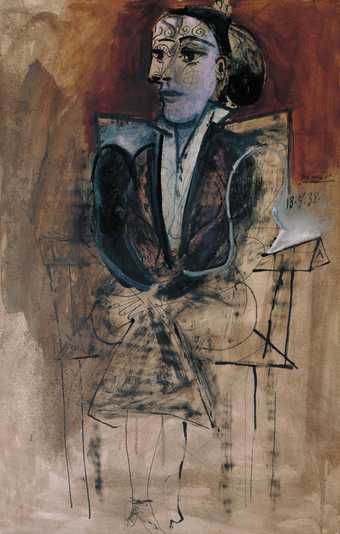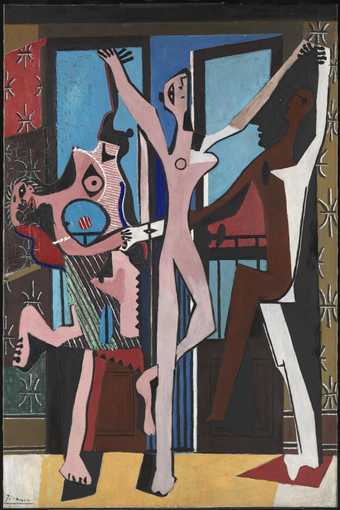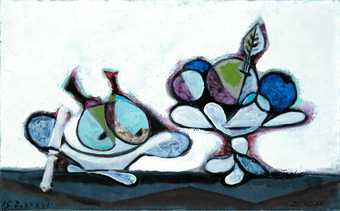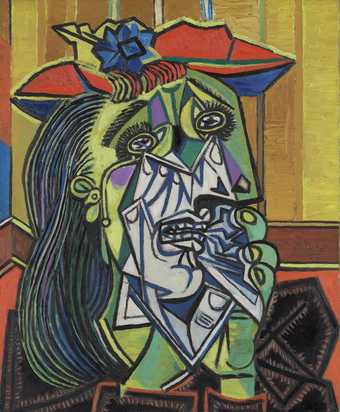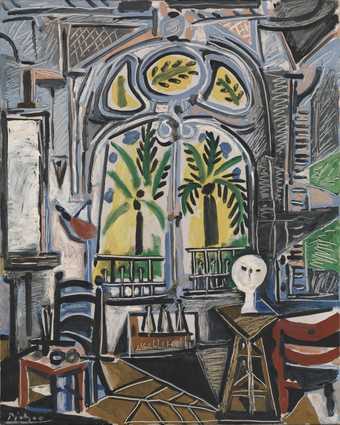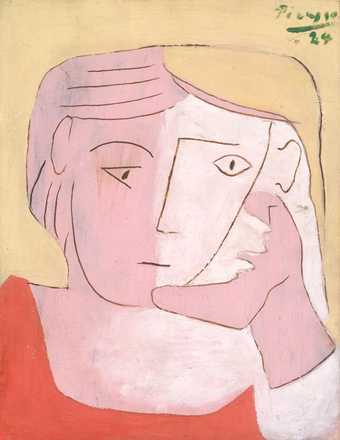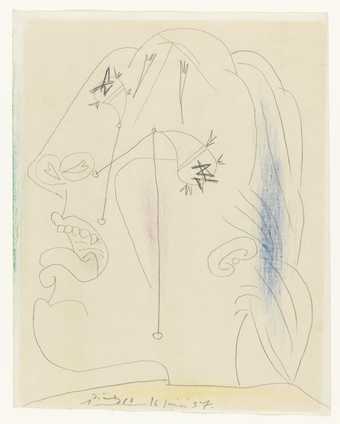
Not on display
- Artist
- Pablo Picasso 1881–1973
- Original title
- Buste de femme
- Medium
- Oil paint on canvas
- Dimensions
- Support: 810 × 650 mm
- Collection
- Lent from a private collection 2011
On long term loan - Reference
- L03007
Summary
Bust of a Woman is a painting in oil on canvas by Pablo Picasso. It depicts a woman whose body is rendered in a semi-abstract style. The face is painted half in white and half in grey, suggesting light and shadow, while the red horizontal and purple vertical lines on the lower and upper halves of the canvas provide a chaotic background. The woman’s dress is green, and this colour is picked up in the bonnet of her hat, as is the yellow of her hair.
Picasso painted Bust of a Woman in Paris on 5 May 1944, during the final months of the Nazi Occupation. Although his wartime work is often seen as austerely monochromatic, the higher colouring of this work may suggest the prospect of liberation. His model was the photographer Dora Maar and the painting shows the typical physiognomy that he attributed to her and that had appeared in supremely anguished form seven years earlier in Weeping Woman 1937 (Tate T05010). In Bust of a Woman Maar is shown wearing a hat and green clothing, and sits on a black metal chair. The angular and planar structure of her face are achieved with a linear simplicity, allowing for the contrasting orientation of nose and mouth. This configuration occurs repeatedly in the sequence of 1944 portraits of which this is one. Another, painted on the same day and also titled Bust of a Woman (private collection), shows a taller hat, but taken together the two works reveal how Picasso rethought the structure of the shoulders and upper arms from canvas to canvas. At times, as here, the upper arms have a brick-like shape, whereas in others they are almost detached. Eventually, in Seated Woman 1944 (Musée Picasso, Paris), painted in July of the same year, the depiction of Maar is both more elaborate and more realistic.
Picasso painted Bust of a Woman in his studio at Rue des Grands-Augustins where he had painted (and Maar had photographed) Guernica in 1937 (Museo Nacional Centro de Arte Reina Sofía, Madrid). With the crumbling of the Axis powers, repression in occupied France intensified. In late February 1944 the poets Robert Desnos, an associate through surrealist circles, and Max Jacob, whose friendship with Picasso stretched back to the early years of the century, were arrested by the Nazis and deported as Jews. Jacob died of pneumonia at Drancy and Desnos died of typhus in Germany. On 19 March 1944, however, Picasso’s friends were able to stage a performance of his play Le Désir attrapé par la queue (Desire Caught by the Tail). As well as Maar, the performers were drawn from the young intelligentsia of occupied Paris: Albert Camus directed, Jean-Paul Sartre and Simone de Beauvoir were among the performers, and the play took place in the studio of the writer Michel Leiris and his art dealer wife Louise Leiris. Bust of a Woman and its associated series captures this complex moment of fear and hope that would lead Picasso to join the Communist Party in October 1944.
Further reading
Pierre Daix, Picasso: Life and Art, New York 1993.
Elizabeth Cowling, Picasso: Style and Meaning, London 2002.
Christoph Grunenberg and Linda Morris, Picasso: Peace and Freedom, exhibition catalogue, Tate Liverpool, Liverpool 2010.
Matthew Gale
January 2011
Does this text contain inaccurate information or language that you feel we should improve or change? We would like to hear from you.
Display caption
This is a portrait of the artist Dora Maar. Picasso painted it in May 1944, during the final weeks of the Nazi Occupation of Paris during World War II. Deprivation and tension were high in the city. Many people faced persecution for their religion, race, sexuality or disability. This led to imprisonment or death.
Maar’s face is painted in black and white. This contrasts with the red and purple background, and the bright green of her dress. This combination of styles and colours appears to represent a complex moment of both fear and hope, when many believed the occupation of Paris might be coming to an end.
Gallery label, July 2020
Does this text contain inaccurate information or language that you feel we should improve or change? We would like to hear from you.
Explore
- abstraction(8,615)
-
- from recognisable sources(3,634)
-
- figure(2,270)
- formal qualities(12,454)
-
- cubist space(86)
- domestic(1,795)
- clothing and personal items(5,879)
-
- hat(1,437)
- individuals: female(1,698)
You might like
-
Pablo Picasso Bust of a Woman
1909 -
Pablo Picasso Nude Woman in a Red Armchair
1932 -
Pablo Picasso Faun Revealing a Sleeping Woman (Jupiter and Antiope, after Rembrandt)
1936 -
Pablo Picasso Woman in an Armchair No.1 (The Polish Cloak)
1949 -
Pablo Picasso Woman at the Window
1952 -
Pablo Picasso Portrait of a Woman after Cranach the Younger
1958 -
Pablo Picasso Goat’s Skull, Bottle and Candle
1952 -
Pablo Picasso Dora Maar Seated
1938 -
Pablo Picasso The Three Dancers
1925 -
Pablo Picasso Dish of Pears
1936 -
Pablo Picasso Nude Woman with Necklace
1968 -
Pablo Picasso Weeping Woman
1937 -
Pablo Picasso The Studio
1955 -
Pablo Picasso Head of a Woman
1924 -
Pablo Picasso Weeping Woman
1937


